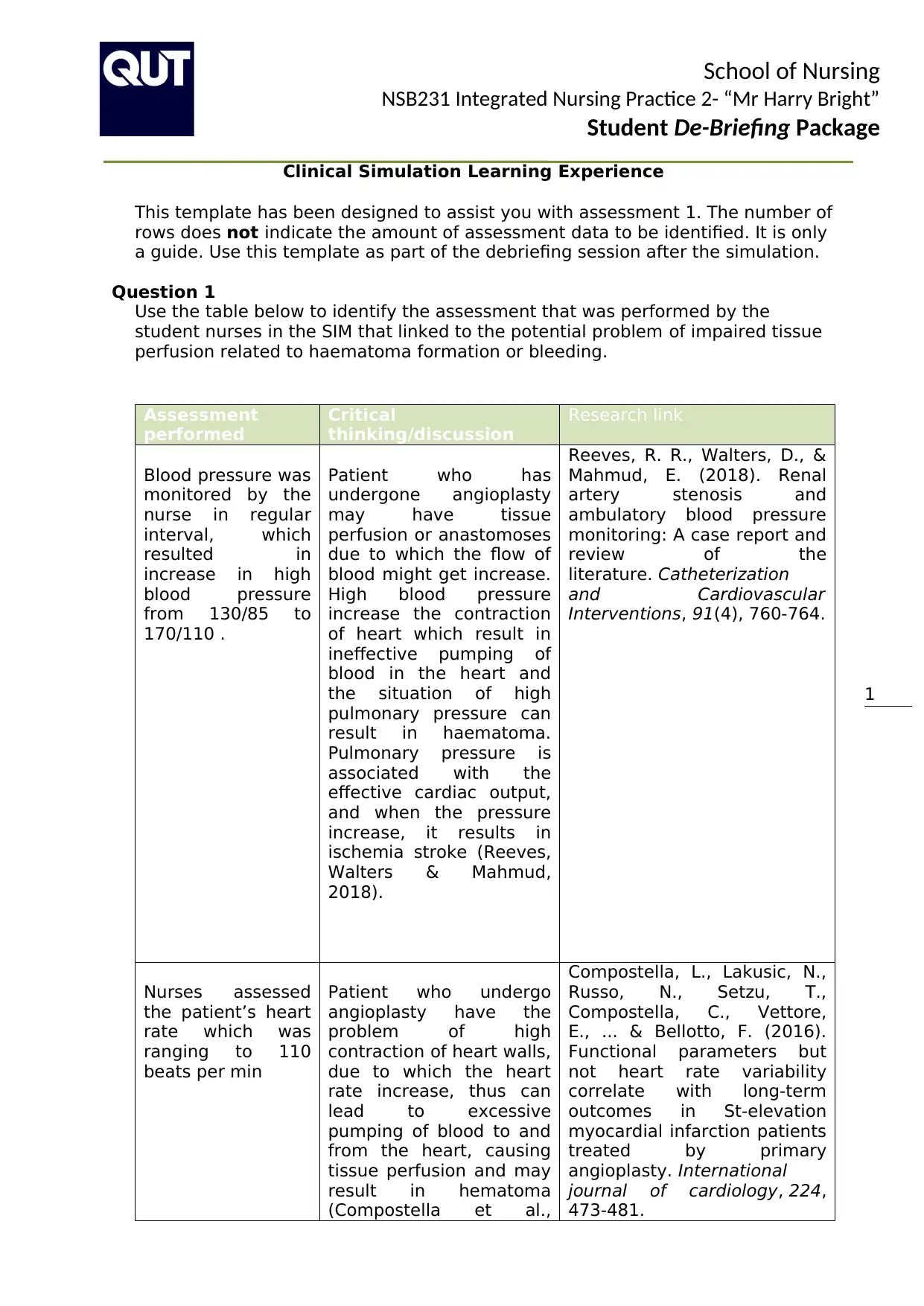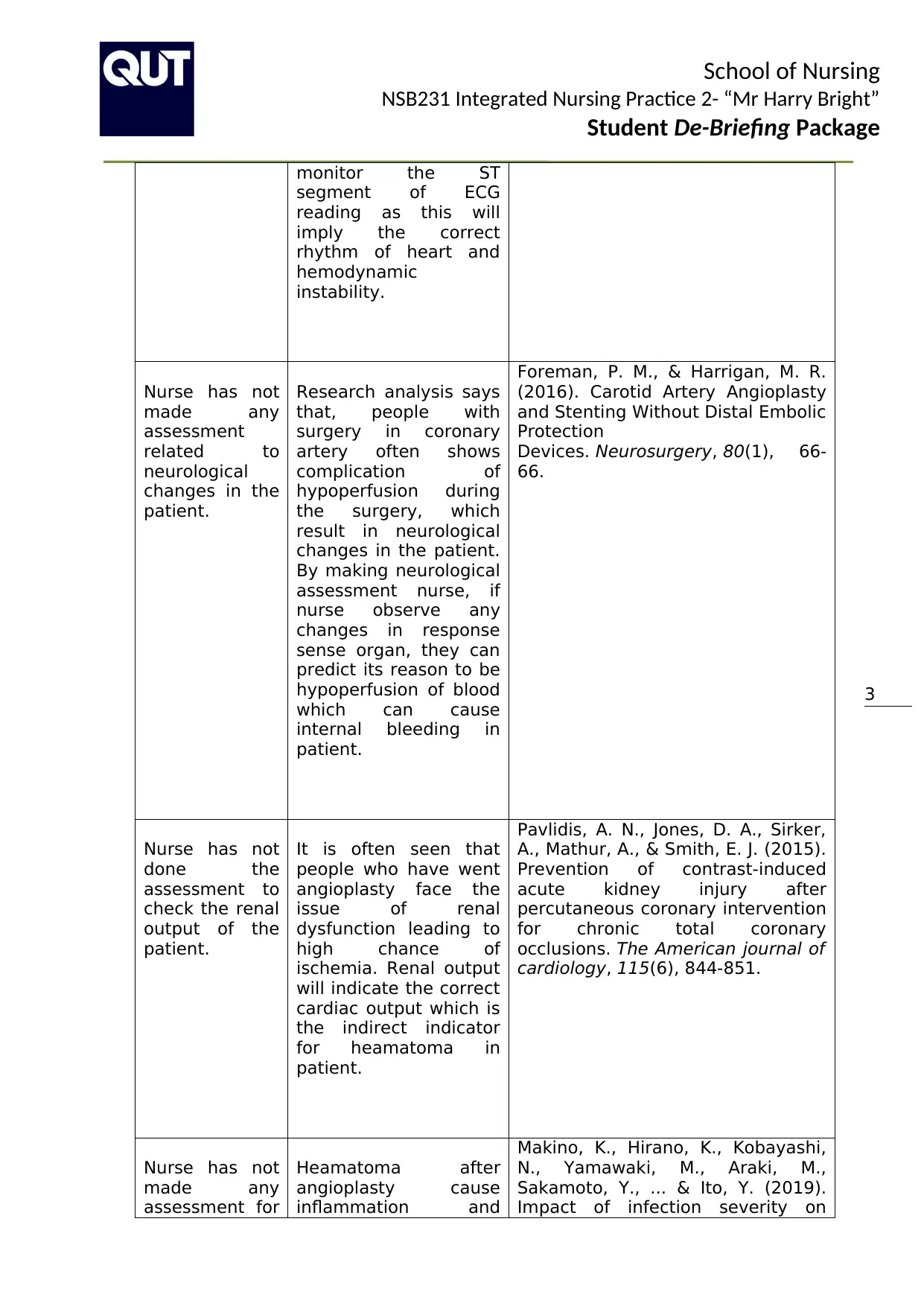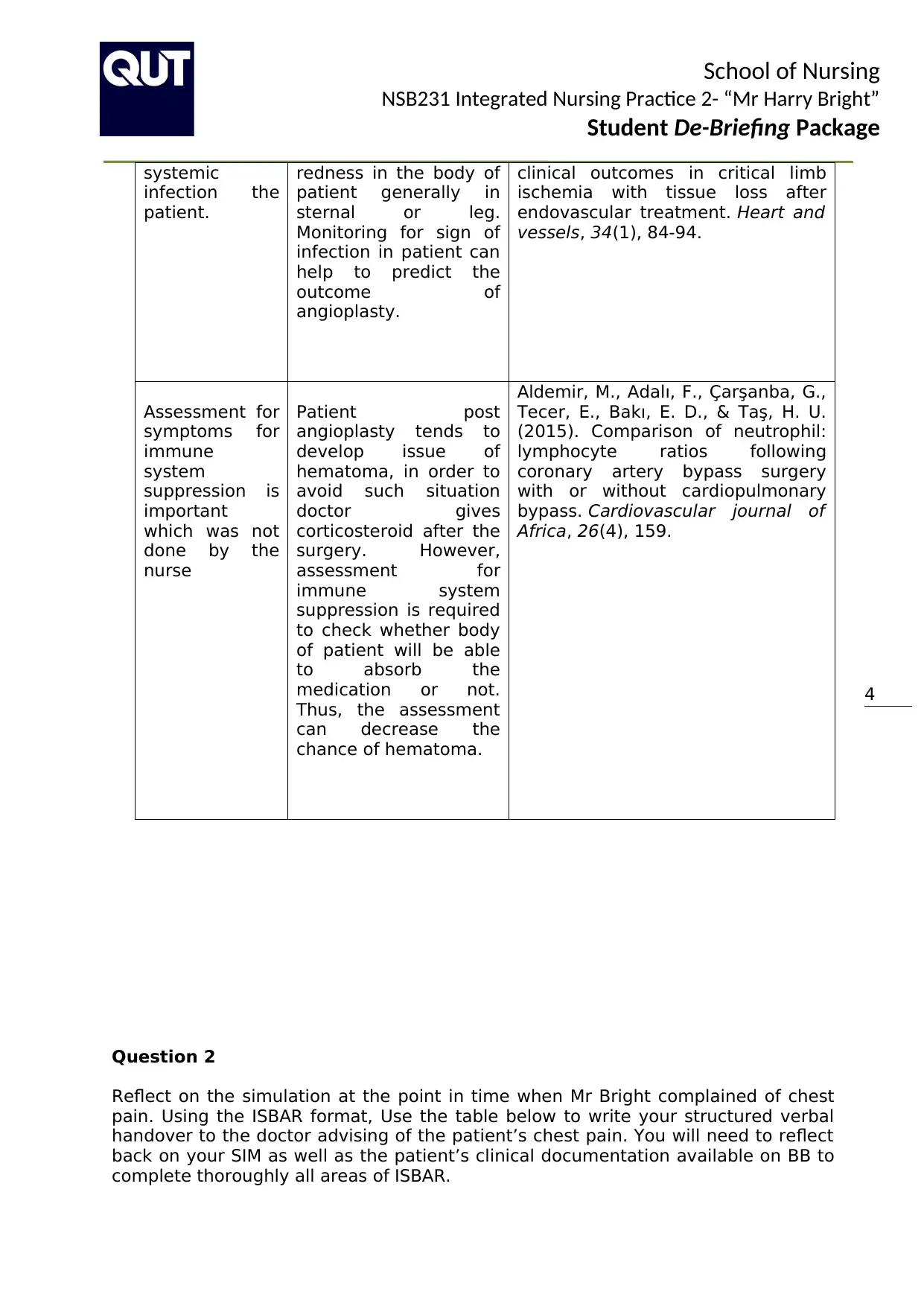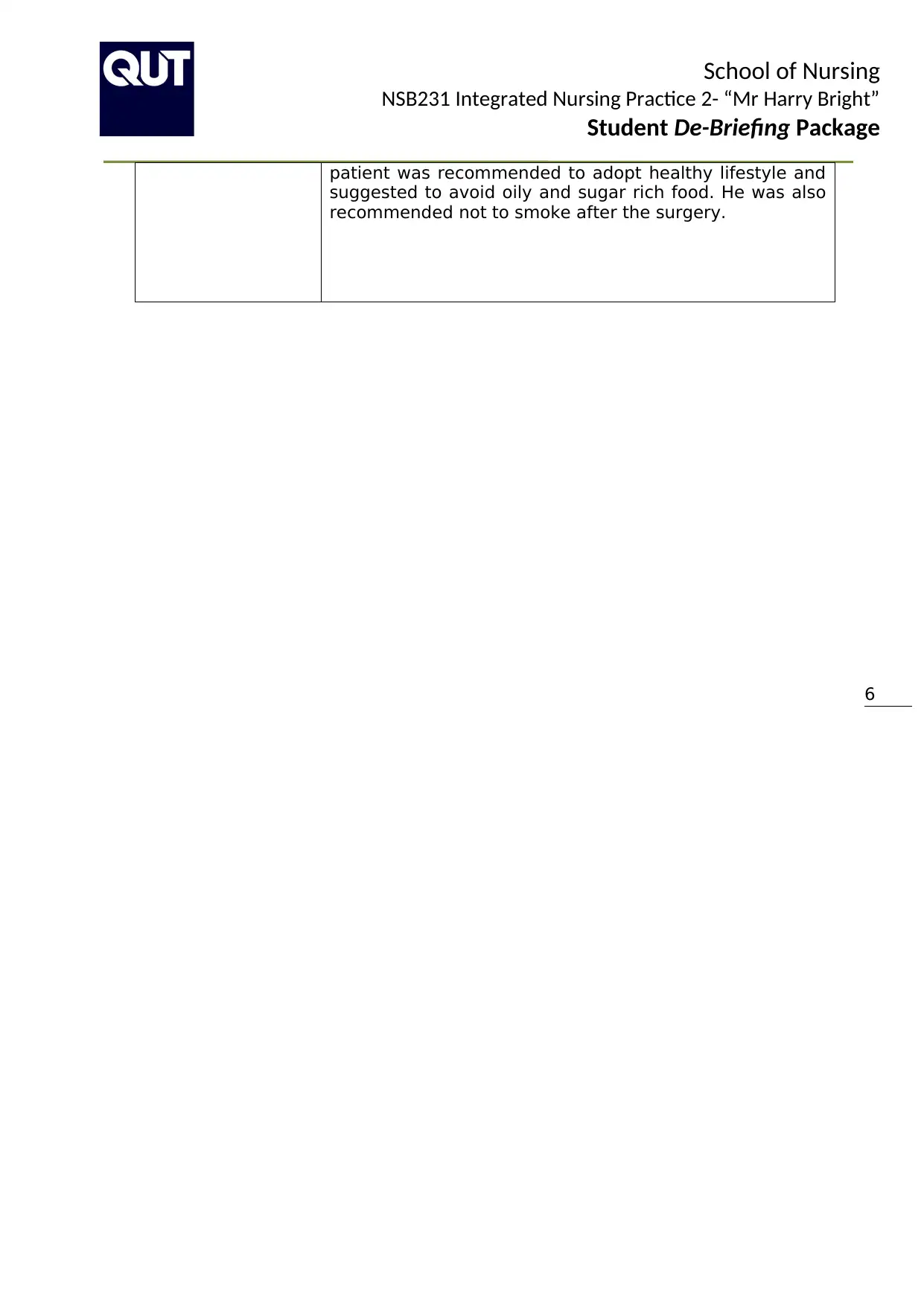NSB231 Integrated Nursing: Harry Bright Simulation Critical Analysis
VerifiedAdded on 2023/04/11
|6
|1443
|156
Report
AI Summary
This document presents a student's de-briefing package for a clinical simulation learning experience involving a patient named Mr. Harry Bright (NSB231). The analysis identifies assessments performed and not performed by student nurses related to impaired tissue perfusion, hematoma formation, and bleeding risks post-angioplasty. It includes critical thinking discussions and research links supporting the analysis. The report also features an ISBAR (Identification, Situation, Background, Assessment, Recommendation) structured verbal handover to a doctor, addressing the patient's chest pain, highlighting the importance of ECG monitoring and lifestyle recommendations. The simulation emphasizes critical thinking, patient assessment skills, and effective communication in nursing practice.

1
School of Nursing
NSB231 Integrated Nursing Practice 2- “Mr Harry Bright”
Student De-Briefing Package
Clinical Simulation Learning Experience
This template has been designed to assist you with assessment 1. The number of
rows does not indicate the amount of assessment data to be identified. It is only
a guide. Use this template as part of the debriefing session after the simulation.
Question 1
Use the table below to identify the assessment that was performed by the
student nurses in the SIM that linked to the potential problem of impaired tissue
perfusion related to haematoma formation or bleeding.
Assessment
performed
Critical
thinking/discussion
Research link
Blood pressure was
monitored by the
nurse in regular
interval, which
resulted in
increase in high
blood pressure
from 130/85 to
170/110 .
Patient who has
undergone angioplasty
may have tissue
perfusion or anastomoses
due to which the flow of
blood might get increase.
High blood pressure
increase the contraction
of heart which result in
ineffective pumping of
blood in the heart and
the situation of high
pulmonary pressure can
result in haematoma.
Pulmonary pressure is
associated with the
effective cardiac output,
and when the pressure
increase, it results in
ischemia stroke (Reeves,
Walters & Mahmud,
2018).
Reeves, R. R., Walters, D., &
Mahmud, E. (2018). Renal
artery stenosis and
ambulatory blood pressure
monitoring: A case report and
review of the
literature. Catheterization
and Cardiovascular
Interventions, 91(4), 760-764.
Nurses assessed
the patient’s heart
rate which was
ranging to 110
beats per min
Patient who undergo
angioplasty have the
problem of high
contraction of heart walls,
due to which the heart
rate increase, thus can
lead to excessive
pumping of blood to and
from the heart, causing
tissue perfusion and may
result in hematoma
(Compostella et al.,
Compostella, L., Lakusic, N.,
Russo, N., Setzu, T.,
Compostella, C., Vettore,
E., ... & Bellotto, F. (2016).
Functional parameters but
not heart rate variability
correlate with long-term
outcomes in St-elevation
myocardial infarction patients
treated by primary
angioplasty. International
journal of cardiology, 224,
473-481.
School of Nursing
NSB231 Integrated Nursing Practice 2- “Mr Harry Bright”
Student De-Briefing Package
Clinical Simulation Learning Experience
This template has been designed to assist you with assessment 1. The number of
rows does not indicate the amount of assessment data to be identified. It is only
a guide. Use this template as part of the debriefing session after the simulation.
Question 1
Use the table below to identify the assessment that was performed by the
student nurses in the SIM that linked to the potential problem of impaired tissue
perfusion related to haematoma formation or bleeding.
Assessment
performed
Critical
thinking/discussion
Research link
Blood pressure was
monitored by the
nurse in regular
interval, which
resulted in
increase in high
blood pressure
from 130/85 to
170/110 .
Patient who has
undergone angioplasty
may have tissue
perfusion or anastomoses
due to which the flow of
blood might get increase.
High blood pressure
increase the contraction
of heart which result in
ineffective pumping of
blood in the heart and
the situation of high
pulmonary pressure can
result in haematoma.
Pulmonary pressure is
associated with the
effective cardiac output,
and when the pressure
increase, it results in
ischemia stroke (Reeves,
Walters & Mahmud,
2018).
Reeves, R. R., Walters, D., &
Mahmud, E. (2018). Renal
artery stenosis and
ambulatory blood pressure
monitoring: A case report and
review of the
literature. Catheterization
and Cardiovascular
Interventions, 91(4), 760-764.
Nurses assessed
the patient’s heart
rate which was
ranging to 110
beats per min
Patient who undergo
angioplasty have the
problem of high
contraction of heart walls,
due to which the heart
rate increase, thus can
lead to excessive
pumping of blood to and
from the heart, causing
tissue perfusion and may
result in hematoma
(Compostella et al.,
Compostella, L., Lakusic, N.,
Russo, N., Setzu, T.,
Compostella, C., Vettore,
E., ... & Bellotto, F. (2016).
Functional parameters but
not heart rate variability
correlate with long-term
outcomes in St-elevation
myocardial infarction patients
treated by primary
angioplasty. International
journal of cardiology, 224,
473-481.
Paraphrase This Document
Need a fresh take? Get an instant paraphrase of this document with our AI Paraphraser

2
School of Nursing
NSB231 Integrated Nursing Practice 2- “Mr Harry Bright”
Student De-Briefing Package
2016).
Nurse has make
assessment of pain
in the patient and
noticed the change
in pain score from
8/10 to 10/10. As
nursing
intervention he
was administered
with morphine to
control the pain.
Morphine is known to
decrease heart rate,
pressure in blood and
venous return. It is also
knowing to stimulate
histamine mediated
process which prevent
any kind of infection. It
helps to lower the
myocardial oxygen
demand in patient post
angioplasty. This can help
to eliminate the chance
of any tissue perfusion.
Bellandi, B., Zocchi, C.,
Xanthopoulou, I., Scudiero, F.,
Valenti, R., Migliorini, A., ... &
Parodi, G. (2016). Morphine
use and myocardial
reperfusion in patients with
acute myocardial infarction
treated with primary
PCI. International journal of
cardiology, 221, 567-571.
Use the table below to identify the assessment that was not performed by the
student nurses in the SIM that linked to the potential problem of impaired tissue
perfusion related to haematoma formation or bleeding.
Assessment
NOT
performed
Critical
thinking/discussion
Research link
Nurse has not
made an
assessment for
arrhythmias
and monitored
the changes in
ST segment by
employed an
ECG test soon
after coronary
angioplasty.
Research says that
patient who has
undergone angioplasty
have irregular rhythm
of sinus in heart and
result in low cardiac
output in the patient.
Thus, increase the
chance of hematoma
leading to myocardial
ischemia. In order to
know that current
situation of the patient
it is important to
Rhim, J. K., Jeon, J. P., Park, J. J.,
Choi, H. J., Cho, Y. D., Sheen, S. H.,
& Jang, K. S. (2016). Prediction of
prolonged hemodynamic instability
during carotid angioplasty and
stenting. Neurointervention, 11(2),
120.
Sharif, S. E., & Alway, S. (2016).
The diagnostic value of exercise
stress testing for cardiovascular
disease is more than just st
segment changes: a review. J.
Integr. Cardiol, 2(4), 41-55.
School of Nursing
NSB231 Integrated Nursing Practice 2- “Mr Harry Bright”
Student De-Briefing Package
2016).
Nurse has make
assessment of pain
in the patient and
noticed the change
in pain score from
8/10 to 10/10. As
nursing
intervention he
was administered
with morphine to
control the pain.
Morphine is known to
decrease heart rate,
pressure in blood and
venous return. It is also
knowing to stimulate
histamine mediated
process which prevent
any kind of infection. It
helps to lower the
myocardial oxygen
demand in patient post
angioplasty. This can help
to eliminate the chance
of any tissue perfusion.
Bellandi, B., Zocchi, C.,
Xanthopoulou, I., Scudiero, F.,
Valenti, R., Migliorini, A., ... &
Parodi, G. (2016). Morphine
use and myocardial
reperfusion in patients with
acute myocardial infarction
treated with primary
PCI. International journal of
cardiology, 221, 567-571.
Use the table below to identify the assessment that was not performed by the
student nurses in the SIM that linked to the potential problem of impaired tissue
perfusion related to haematoma formation or bleeding.
Assessment
NOT
performed
Critical
thinking/discussion
Research link
Nurse has not
made an
assessment for
arrhythmias
and monitored
the changes in
ST segment by
employed an
ECG test soon
after coronary
angioplasty.
Research says that
patient who has
undergone angioplasty
have irregular rhythm
of sinus in heart and
result in low cardiac
output in the patient.
Thus, increase the
chance of hematoma
leading to myocardial
ischemia. In order to
know that current
situation of the patient
it is important to
Rhim, J. K., Jeon, J. P., Park, J. J.,
Choi, H. J., Cho, Y. D., Sheen, S. H.,
& Jang, K. S. (2016). Prediction of
prolonged hemodynamic instability
during carotid angioplasty and
stenting. Neurointervention, 11(2),
120.
Sharif, S. E., & Alway, S. (2016).
The diagnostic value of exercise
stress testing for cardiovascular
disease is more than just st
segment changes: a review. J.
Integr. Cardiol, 2(4), 41-55.

3
School of Nursing
NSB231 Integrated Nursing Practice 2- “Mr Harry Bright”
Student De-Briefing Package
monitor the ST
segment of ECG
reading as this will
imply the correct
rhythm of heart and
hemodynamic
instability.
Nurse has not
made any
assessment
related to
neurological
changes in the
patient.
Research analysis says
that, people with
surgery in coronary
artery often shows
complication of
hypoperfusion during
the surgery, which
result in neurological
changes in the patient.
By making neurological
assessment nurse, if
nurse observe any
changes in response
sense organ, they can
predict its reason to be
hypoperfusion of blood
which can cause
internal bleeding in
patient.
Foreman, P. M., & Harrigan, M. R.
(2016). Carotid Artery Angioplasty
and Stenting Without Distal Embolic
Protection
Devices. Neurosurgery, 80(1), 66-
66.
Nurse has not
done the
assessment to
check the renal
output of the
patient.
It is often seen that
people who have went
angioplasty face the
issue of renal
dysfunction leading to
high chance of
ischemia. Renal output
will indicate the correct
cardiac output which is
the indirect indicator
for heamatoma in
patient.
Pavlidis, A. N., Jones, D. A., Sirker,
A., Mathur, A., & Smith, E. J. (2015).
Prevention of contrast-induced
acute kidney injury after
percutaneous coronary intervention
for chronic total coronary
occlusions. The American journal of
cardiology, 115(6), 844-851.
Nurse has not
made any
assessment for
Heamatoma after
angioplasty cause
inflammation and
Makino, K., Hirano, K., Kobayashi,
N., Yamawaki, M., Araki, M.,
Sakamoto, Y., ... & Ito, Y. (2019).
Impact of infection severity on
School of Nursing
NSB231 Integrated Nursing Practice 2- “Mr Harry Bright”
Student De-Briefing Package
monitor the ST
segment of ECG
reading as this will
imply the correct
rhythm of heart and
hemodynamic
instability.
Nurse has not
made any
assessment
related to
neurological
changes in the
patient.
Research analysis says
that, people with
surgery in coronary
artery often shows
complication of
hypoperfusion during
the surgery, which
result in neurological
changes in the patient.
By making neurological
assessment nurse, if
nurse observe any
changes in response
sense organ, they can
predict its reason to be
hypoperfusion of blood
which can cause
internal bleeding in
patient.
Foreman, P. M., & Harrigan, M. R.
(2016). Carotid Artery Angioplasty
and Stenting Without Distal Embolic
Protection
Devices. Neurosurgery, 80(1), 66-
66.
Nurse has not
done the
assessment to
check the renal
output of the
patient.
It is often seen that
people who have went
angioplasty face the
issue of renal
dysfunction leading to
high chance of
ischemia. Renal output
will indicate the correct
cardiac output which is
the indirect indicator
for heamatoma in
patient.
Pavlidis, A. N., Jones, D. A., Sirker,
A., Mathur, A., & Smith, E. J. (2015).
Prevention of contrast-induced
acute kidney injury after
percutaneous coronary intervention
for chronic total coronary
occlusions. The American journal of
cardiology, 115(6), 844-851.
Nurse has not
made any
assessment for
Heamatoma after
angioplasty cause
inflammation and
Makino, K., Hirano, K., Kobayashi,
N., Yamawaki, M., Araki, M.,
Sakamoto, Y., ... & Ito, Y. (2019).
Impact of infection severity on
⊘ This is a preview!⊘
Do you want full access?
Subscribe today to unlock all pages.

Trusted by 1+ million students worldwide

4
School of Nursing
NSB231 Integrated Nursing Practice 2- “Mr Harry Bright”
Student De-Briefing Package
systemic
infection the
patient.
redness in the body of
patient generally in
sternal or leg.
Monitoring for sign of
infection in patient can
help to predict the
outcome of
angioplasty.
clinical outcomes in critical limb
ischemia with tissue loss after
endovascular treatment. Heart and
vessels, 34(1), 84-94.
Assessment for
symptoms for
immune
system
suppression is
important
which was not
done by the
nurse
Patient post
angioplasty tends to
develop issue of
hematoma, in order to
avoid such situation
doctor gives
corticosteroid after the
surgery. However,
assessment for
immune system
suppression is required
to check whether body
of patient will be able
to absorb the
medication or not.
Thus, the assessment
can decrease the
chance of hematoma.
Aldemir, M., Adalı, F., Çarşanba, G.,
Tecer, E., Bakı, E. D., & Taş, H. U.
(2015). Comparison of neutrophil:
lymphocyte ratios following
coronary artery bypass surgery
with or without cardiopulmonary
bypass. Cardiovascular journal of
Africa, 26(4), 159.
Question 2
Reflect on the simulation at the point in time when Mr Bright complained of chest
pain. Using the ISBAR format, Use the table below to write your structured verbal
handover to the doctor advising of the patient’s chest pain. You will need to reflect
back on your SIM as well as the patient’s clinical documentation available on BB to
complete thoroughly all areas of ISBAR.
School of Nursing
NSB231 Integrated Nursing Practice 2- “Mr Harry Bright”
Student De-Briefing Package
systemic
infection the
patient.
redness in the body of
patient generally in
sternal or leg.
Monitoring for sign of
infection in patient can
help to predict the
outcome of
angioplasty.
clinical outcomes in critical limb
ischemia with tissue loss after
endovascular treatment. Heart and
vessels, 34(1), 84-94.
Assessment for
symptoms for
immune
system
suppression is
important
which was not
done by the
nurse
Patient post
angioplasty tends to
develop issue of
hematoma, in order to
avoid such situation
doctor gives
corticosteroid after the
surgery. However,
assessment for
immune system
suppression is required
to check whether body
of patient will be able
to absorb the
medication or not.
Thus, the assessment
can decrease the
chance of hematoma.
Aldemir, M., Adalı, F., Çarşanba, G.,
Tecer, E., Bakı, E. D., & Taş, H. U.
(2015). Comparison of neutrophil:
lymphocyte ratios following
coronary artery bypass surgery
with or without cardiopulmonary
bypass. Cardiovascular journal of
Africa, 26(4), 159.
Question 2
Reflect on the simulation at the point in time when Mr Bright complained of chest
pain. Using the ISBAR format, Use the table below to write your structured verbal
handover to the doctor advising of the patient’s chest pain. You will need to reflect
back on your SIM as well as the patient’s clinical documentation available on BB to
complete thoroughly all areas of ISBAR.
Paraphrase This Document
Need a fresh take? Get an instant paraphrase of this document with our AI Paraphraser

5
School of Nursing
NSB231 Integrated Nursing Practice 2- “Mr Harry Bright”
Student De-Briefing Package
If you have not attended your SIM this week use this time to research chest pain
post PCI to assist you in your SIM and for this assessment 1 task. Research ISBAR
and what you are required to communicate in each step.
Handover Tool Written Script
I- IDENTIFICATION Nurse have to initially introduce herself to the patient and
identify the patient. With quality communication with
patient, it came to know, that his name is Mr Harry Bright
who had underwent angioplasty as he was having
unstable angina.
S- SITUATION
The current situation of patient observed by physical
examination highlights that, blood pressure of patient
has gone high from 130/85 to 170/110 and heart rate has
increase to 110 beat per minute. On examination of the
chest pain, nurse noticed that pain score has gone from
8/10 to 10/10. He was showing the symptom of mouth
dripping which is related to chest pain.
B-BACKGROUND
NOT PROVIDED BY STUDENT
A-ASSESSMENT
On assessment of patient, he was having high blood
pressure and high pulse rate. The patient was suffering
from tremendous chest pain of score 10/10, nurse has
administered morphine medication to the patient to
resolved the condition of patient. Nurse need to assess
patient in order to know the chance of hematoma and
ischemia stroke by examining ECG.
R-
RECOMMENDATION
As the patient has undergone angioplasty and
complaining of severe chest pain, the patient was
recommended to go for ECG test in order to evaluate the
risk of ischemia stroke and hematoma. Further, the
School of Nursing
NSB231 Integrated Nursing Practice 2- “Mr Harry Bright”
Student De-Briefing Package
If you have not attended your SIM this week use this time to research chest pain
post PCI to assist you in your SIM and for this assessment 1 task. Research ISBAR
and what you are required to communicate in each step.
Handover Tool Written Script
I- IDENTIFICATION Nurse have to initially introduce herself to the patient and
identify the patient. With quality communication with
patient, it came to know, that his name is Mr Harry Bright
who had underwent angioplasty as he was having
unstable angina.
S- SITUATION
The current situation of patient observed by physical
examination highlights that, blood pressure of patient
has gone high from 130/85 to 170/110 and heart rate has
increase to 110 beat per minute. On examination of the
chest pain, nurse noticed that pain score has gone from
8/10 to 10/10. He was showing the symptom of mouth
dripping which is related to chest pain.
B-BACKGROUND
NOT PROVIDED BY STUDENT
A-ASSESSMENT
On assessment of patient, he was having high blood
pressure and high pulse rate. The patient was suffering
from tremendous chest pain of score 10/10, nurse has
administered morphine medication to the patient to
resolved the condition of patient. Nurse need to assess
patient in order to know the chance of hematoma and
ischemia stroke by examining ECG.
R-
RECOMMENDATION
As the patient has undergone angioplasty and
complaining of severe chest pain, the patient was
recommended to go for ECG test in order to evaluate the
risk of ischemia stroke and hematoma. Further, the

6
School of Nursing
NSB231 Integrated Nursing Practice 2- “Mr Harry Bright”
Student De-Briefing Package
patient was recommended to adopt healthy lifestyle and
suggested to avoid oily and sugar rich food. He was also
recommended not to smoke after the surgery.
School of Nursing
NSB231 Integrated Nursing Practice 2- “Mr Harry Bright”
Student De-Briefing Package
patient was recommended to adopt healthy lifestyle and
suggested to avoid oily and sugar rich food. He was also
recommended not to smoke after the surgery.
⊘ This is a preview!⊘
Do you want full access?
Subscribe today to unlock all pages.

Trusted by 1+ million students worldwide
1 out of 6
Related Documents
Your All-in-One AI-Powered Toolkit for Academic Success.
+13062052269
info@desklib.com
Available 24*7 on WhatsApp / Email
![[object Object]](/_next/static/media/star-bottom.7253800d.svg)
Unlock your academic potential
Copyright © 2020–2025 A2Z Services. All Rights Reserved. Developed and managed by ZUCOL.





